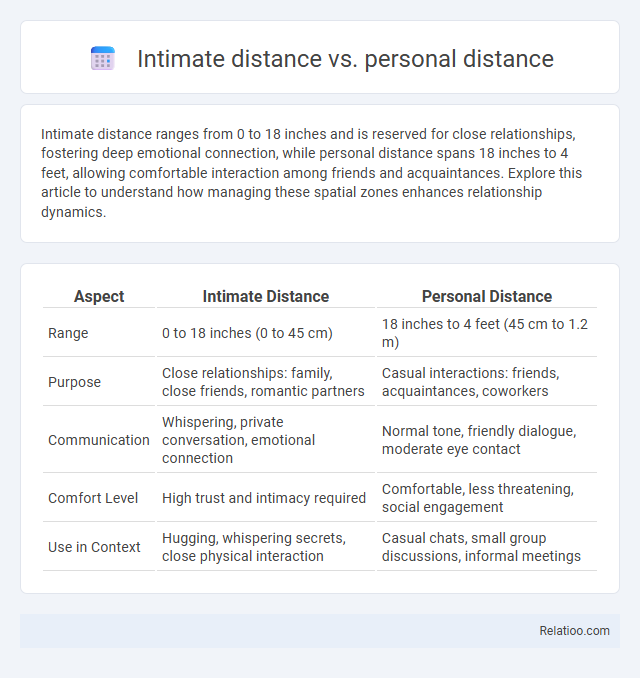Intimate distance ranges from 0 to 18 inches and is reserved for close relationships, fostering deep emotional connection, while personal distance spans 18 inches to 4 feet, allowing comfortable interaction among friends and acquaintances. Explore this article to understand how managing these spatial zones enhances relationship dynamics.
Table of Comparison
| Aspect | Intimate Distance | Personal Distance |
|---|---|---|
| Range | 0 to 18 inches (0 to 45 cm) | 18 inches to 4 feet (45 cm to 1.2 m) |
| Purpose | Close relationships: family, close friends, romantic partners | Casual interactions: friends, acquaintances, coworkers |
| Communication | Whispering, private conversation, emotional connection | Normal tone, friendly dialogue, moderate eye contact |
| Comfort Level | High trust and intimacy required | Comfortable, less threatening, social engagement |
| Use in Context | Hugging, whispering secrets, close physical interaction | Casual chats, small group discussions, informal meetings |
Understanding Interpersonal Distances
Understanding interpersonal distances involves recognizing the differences between intimate distance, personal distance, and distancing behaviors. Intimate distance ranges from 0 to 18 inches, reserved for close relationships like family and partners, where physical contact is common. Personal distance spans 18 inches to 4 feet, suitable for conversations among friends or acquaintances, while deliberate distancing occurs when individuals expand their space beyond these ranges to establish psychological or emotional boundaries.
Defining Intimate Distance
Intimate distance is the closest proximity in interpersonal communication, typically ranging from 0 to 18 inches, reserved for close relationships such as family members, romantic partners, and close friends. Personal distance spans from 18 inches to 4 feet and is used for interactions among friends and acquaintances, allowing for comfortable conversation while maintaining a sense of personal space. Distancing refers to the conscious or unconscious adjustment of physical space to regulate comfort, privacy, and social boundaries in various interpersonal contexts.
Characteristics of Personal Distance
Personal distance, typically ranging from 1.5 to 4 feet, allows comfortable interaction while maintaining individual privacy, unlike intimate distance which is closer and reserved for close relationships. This space facilitates face-to-face conversation without intrusion, supporting clear communication and emotional comfort. Understanding your personal distance helps maintain respect and ease in social and professional settings.
Psychological Impact of Proximity
Intimate distance, typically within 0 to 18 inches, can trigger heightened emotional responses and vulnerability, strongly influencing trust and attachment in relationships. Personal distance, ranging from 18 inches to 4 feet, balances comfort and social interaction while maintaining psychological boundaries that support individual autonomy. Distancing beyond these ranges often signals emotional detachment or defensive behavior, impacting perceptions of safety and social connectedness.
Cultural Variations in Space Boundaries
Cultural variations significantly influence intimate distance, personal distance, and general distancing, shaping how individuals perceive and respect spatial boundaries. In some cultures, close physical proximity during conversations is seen as a sign of warmth and trust, while in others, greater personal distance is maintained to ensure comfort and privacy. Understanding these cultural differences helps You navigate social interactions smoothly, avoiding misunderstandings related to space boundaries.
Intimate Distance in Relationships
Intimate distance, typically ranging from 0 to 18 inches, plays a crucial role in relationships by fostering deep emotional connections and trust between partners. This close spatial proximity allows for nonverbal communication cues like eye contact, touch, and facial expressions, which strengthen intimacy and understanding. While personal distance (18 inches to 4 feet) facilitates casual interactions, maintaining intimate distance is essential for expressing affection and building a secure bond in romantic partnerships.
Personal Distance in Social Settings
Personal distance in social settings typically ranges from 1.5 to 4 feet, allowing enough space for comfortable interaction without invading privacy. This spatial zone enables clear communication and fosters trust while respecting individual boundaries, contrasting with intimate distance (0 to 1.5 feet), which is reserved for close relationships. Understanding and maintaining appropriate personal distance reduces discomfort and promotes positive social dynamics across various cultures.
Navigating Boundaries: Social Cues and Context
Intimate distance ranges from 0 to 18 inches and is reserved for close relationships, where nonverbal cues like eye contact and body language signal comfort or discomfort. Personal distance spans 18 inches to 4 feet, commonly used for conversations with friends or acquaintances, requiring you to interpret subtle social cues to maintain respect and warmth. Distancing involves consciously adjusting physical space based on context and social norms to navigate boundaries effectively and ensure mutual comfort.
Violations and Comfort Zones
Intimate distance, ranging from 0 to 18 inches, is reserved for close relationships, and violations within this zone often cause discomfort or anxiety due to its association with personal privacy. Personal distance, spanning 18 inches to 4 feet, allows comfortable interactions in social and professional contexts; intrusions here can lead to feelings of unease or perceived disrespect. Distancing beyond 4 feet serves as a buffer for casual or formal interactions, and breaches in this zone may signal aggression or invade one's sense of autonomy, disrupting the comfort zone equilibrium.
Tips for Respecting Personal Space
Understanding intimate distance (0-18 inches), personal distance (18 inches to 4 feet), and distancing guidelines helps you respect others' comfort zones effectively. To honor personal space, observe body language cues, maintain appropriate physical gaps during conversations, and avoid sudden intrusions. Prioritizing these tips fosters trust, reduces discomfort, and enhances interpersonal interactions in social or professional settings.

Infographic: Intimate distance vs Personal distance
 relatioo.com
relatioo.com